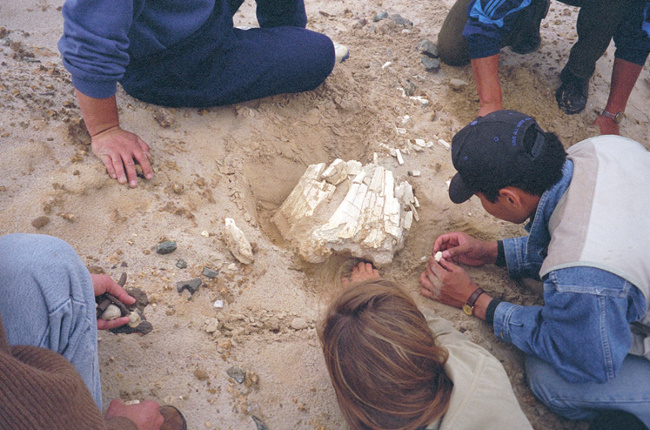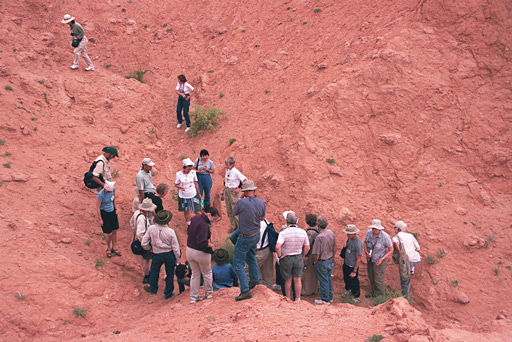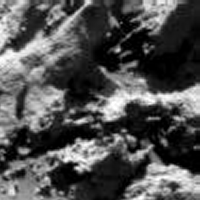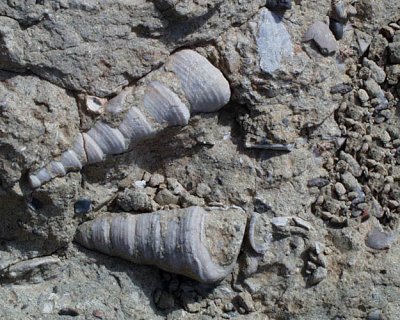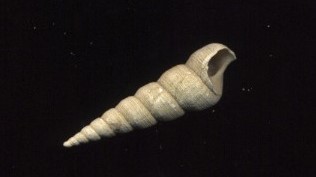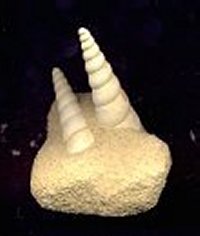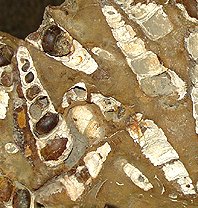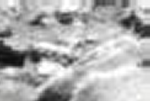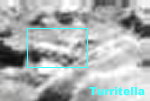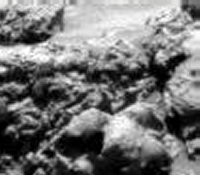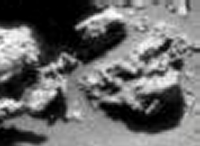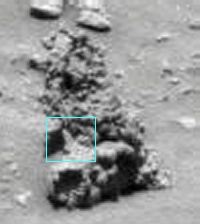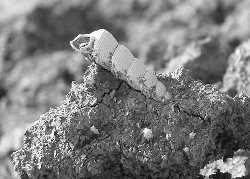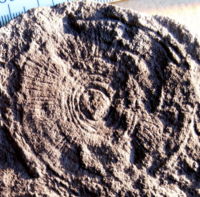|
The Enigmas on Mars 06A |
||||||||||||||||||||||||||
|
Page Two .
This statement is quite false and any fossil hunter will laugh at that comment. The image above is taken from Barton-on-the-Sea, England where the constant action of the water washes the fossils out of the ancient clays of the cliffs... and quite literally they are "just lying around". This despite the thousands of Earthlings hunting them and picking up specimens in a heavily populted area... Now the image
below from Mars
is on a wind swept plain, not a water eroded
beach. However the huge fossil
fields of the Gobi Desert are a better example of
wind erosion. The fossils
are a much harder and more stable material than
the host rock and therefore
will survive in the open quite well, literally
millions of years, while
the sandstone or clay that holds them is soft and
easily broken down and
swept away by wind and water.
|
||||||||||||||||||||||||||
|
The Case For Martian Fossils .
Here are two independant sources from those who have actually visited the Gobi Desert fossil rich fields in Mongolia...
Fossil hunting in the Gobi Desert. We visit an area of the Gobi nicknamed the "Flaming Cliffs" after the red color of the rock there. In the 1920s, a man named Roy Chapman Andrews led an American expedition to this area, unearthing enormous complete skeletons and the first known set of fossilized dinosaur eggs. A Mongolian paleontologist takes our group us around the site and shows us how to look for fossils. Paleontologists say that, compared to other places, searching for fossils in the Gobi is ridiculously easy. Most of the dinosaurs buried there were consumed in sandstorms, and the sand compressed into sandstone. Every year, erosion causes new areas to be uncovered, so in the right places, one can find chips of fossilized bone just lying on the surface.
Considering
the fact that
Mars was once covered in massive oceans as
evidence now proves, it is incomprehensible
to me that we WOULDN'T find some fossil evidence
in the sediments
|
||||||||||||||||||||||||||
|
The Skulls . |
||||||||||||||||||||||||||
|
Spirit Rover Sol 1144 The Case for Turritellas .
posted on 30-3-2007 @ 11:45 AM (ID:3074123) The source of the images is the set taken by Spirit Rover on Sol 1144 "I have
found a "critter"
too!
To help ArMaP retain his composure and explain the "hand" or "claw" we hope the following clips will help. Though unfortunately we cannot get away from the "fossils" In the following images we will use clips from both the black and white version and the color version which ArMap says represents close to true color... |
||||||||||||||||||||||||||
|
The Case for Turritellas .
"Now, you cannot tell me that that "rock" there was formed by any known natural formation process. Should anyone be able to explain how such a thing could have come about, I'd be VERY anxious to hear what it is." - TheBorg There is one possible explaination
on how those "rocks"
formed... Fossil Turritellas, a type of conical
winding gastropod very
common on Earth. Follow me now as I point out many
possible Turritella
type "fossils" in the images in this set. I will
also post some Earth samples
fro comparison. At the end I will value any
comments...
"Yeah! Strange.(the "claw") But what I'm more interested in your pic is this which I've enlarged. Check out the elongated portion on it's right as well as the rectangular stripe running over the top. Looks like a weathered ancient machine part to me!! "- Mike Singh Those conical shapes are again
consistant with Turritella's...
|
||||||||||||||||||||||||||
|
.
|
||||||||||||||||||||||||||
|
Opportunity Rover Digs for Fossils Sol 30 to Sol 33 The "Rotelli" Fossils ...
Some of the images containing the 'fossils' are listed below. Oportunity spent several days drilling in this area. Above I have highlighted several interesting areas as well as two drill marks. 1M130859833EFF0454P2959M2M1.JPG
NASA
Opportunity
Rover Sol 30 Microscopic Imager
One of the most famous anomalies talked about is the "Rotelli" fossil. It was found in these images and is one of the best case samples for life on Mars to date. It was called "rotelli" because of its shape, looking like rotelli pasta on Earth. 
There are many other samples that we
found in these
images and a few are highlighted below... a
"Rotelli" and a "Turritella"....
Three very good specimens of "Turritella"....
|
||||||||||||||||||||||||||
A close-up of the Last Chance rock after it was RAT-treated reveals a tiny spiral-like object (red arrow), likened to curved macaroni, set in a texture that itself is "mysterious". The object may be a cutting artifact of the abrasion tool or it may be a natural, intrinsic component of the rock. Among speculatiions: it is a fossilized organism, but that view is quite tentative. However, some "optimists" are already claiming to see 'nebulous' evidence of other life forms. Visit this MER fossils website for a pictorial summary of such conjectures. |
||||||||||||||||||||||||||
|
A Comparison
|
||||||||||||||||||||||||||
|
Spirit Rover Gusev Crater Sol 386 Lichen Like Fossil ..
Features were left behind by tools ... or were they? MSNBC
Excerpt: A case in point: During Spirit's recent run in the Columbia Hills, the robot used its arm-mounted devices to poke and probe a particular Martian rock. One piece of hardware — the Rock Abrasion Tool, known better as the RAT — was on hand to expose fresh Martian rock. The RAT utilizes a single diamond matrix wheel to scrape the rock surface. It does this ever so slightly and progressively to achieve a wanted depth. The abraded surface is actively swept clean by a brush to prepare it for scientific examinations. Once the rock was worked over, Spirit’s Microscopic Imager went in for close-up looks at the results. And within the images, an odd feature could be seen, seemingly a pattern of something more biological than just rock. Comments:
"While I have not traced the precise path and geometry, it is suspected that the central ‘fuzzy’ patch is due to the Mössbauer placement onto a portion of the mosaic where brush bits had accumulated" - Stephen Gorevan, payload lead for the RAT on the Mars Exploration Rover project. Here is the original image (1 of 4) Microscopic Imager Non-linearized
Full frame EDR acquired
on Sol 386 of Spirit's mission to Gusev Crater at
approximately at approximately
13:10:11 Mars local solar time, Microscopic Imager
dust cover commanded
to be OPEN. NASA/JPL/Cornell/USGS
SOURCE: NASA Spirit Rover Data: 2M160631572EFFA2K1P2936M2M1.jpg |
||||||||||||||||||||||||||
|
Cyclomedusa on Earth ..
..
Cyclomedusa is a circular fossil of the Ediacaran biota; it has a circular bump in the middle and as many as five circular growth ridges around it. Many specimens are small, but specimens in excess of 20cm are known. The concentric disks are not necessarily circular, especially when adjacent individuals interfere with each other's growth. Many radial segment lines — somewhat pineapple-like — extend across the outer disks. A few specimens show what might be a stem extending from the center in some direction or other. Cyclomedusa was originally thought to be a jellyfish (Sprigg 1947), but some specimens seem to be distorted to accommodate adjacent specimens on the substrate, apparently indicating a benthic (bottom-dwelling) creature.[2] The markings do not match the musculature pattern of modern jellyfish. The fossils have been conjectured to represent a holdfast for some stalked form — possibly an octacorallian, or something else entirely. Cyclomedusa is widely distributed in Ediacaran strata, with a number of species described. Alternatively, it was thought[citation needed] that the described species actually represent different modes of preservation for one organism or that several different organisms have been grouped together under one name as a form taxon. It is now suggested that Cyclomedusa was a microbial colony (Grazhdankin, in press); D. Grazhdankin reinterprets the concentric rings and radial structures as comparable to those seen in modern-day microbial colonies exposed to homogeneously distributed environmental conditions. Cyclomedusa is known from Neoproterozoic beds in Ediacara (Australia), Finnmark (Norway), Charnwood Forest (England), Olenek (Russia), North China, Newfoundland, Northwest Canada, Podolia (Ukraine), the Ural Mountains (Russia), the White Sea (Russia), and Sonora (Mexico). It is regarded as a member of the Ediacaran biota— a group of somewhat obscure organisms that thrived just before most of the modern multicellular animal phyla appeared. Cyclomedusa has no known relatives. |
||||||||||||||||||||||||||
|
Opportunity Rover Endurance Crater Sol 125 Corals? Microscopic Imager Non-linearized Full frame EDR acquired on Sol 125 of Opportunity's mission to Meridiani Planum at approximately at approximately 12:58:35 Mars local solar time, Microscopic Imager dust cover commanded to be OPEN. NASA/JPL/Cornell/USGS Concentric circular arcs from Opportunity Sol 125 outside of Endurance Crater. About 2 mm in diameter. This one did not have the RAT abrasion of the surface, so the pattern is in the rock. Here is the
original image
SOURCE: NASA Opportunity Rover Data: 1M139283564EFF2829P2976M2M1.jpg |
||||||||||||||||||||||||||
| FAIR USE NOTICE: This page contains copyrighted material the use of which has not been specifically authorized by the copyright owner. Pegasus Research Consortium distributes this material without profit to those who have expressed a prior interest in receiving the included information for research and educational purposes. We believe this constitutes a fair use of any such copyrighted material as provided for in 17 U.S.C § 107. If you wish to use copyrighted material from this site for purposes of your own that go beyond fair use, you must obtain permission from the copyright owner. | ||||||||||||||||||||||||||
|
|

